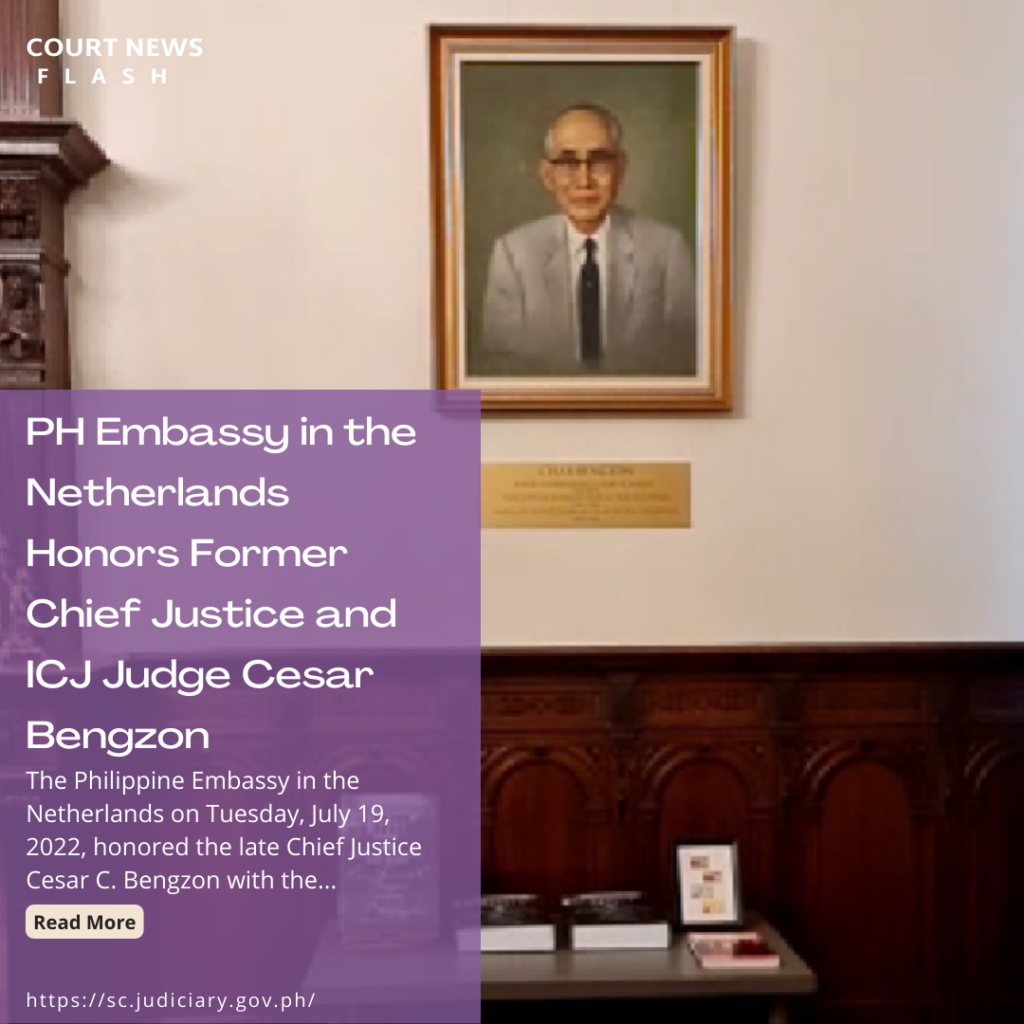
The Philippine Embassy in the Netherlands on Tuesday, July 19, 2022, honored the late Chief Justice Cesar C. Bengzon with the inauguration of the ICJ Judge Cesar Bengzon Hall.
The Embassy dedicated a special sitting room at the ground floor of its newly renovated Chancery to the late Chief Justice Bengzon, the first and only Filipino Judge of the International Court of Justice (ICJ).
Chief Justice Alexander G. Gesmundo was one of the keynote speakers at the event, which also honored two other Filipinos who were appointed to international tribunals—the late Supreme Court Associate Justice Florentino P. Feliciano and former University of the Philippines College of Law Dean Raul C. Pangalangan.
The ceremony was broadcast live by the Embassy via its official Facebook page and was mirrored by the Supreme Court of the Philippines on its website.
In his video message, Chief Justice Gesmundo extolled Chief Justice Bengzon for breaking barriers upon his appointment as the first Filipino to ICJ. He said that with the late Chief Justice “impressed upon the international legal community that Philippine jurists are world-class” with his knowledge and prudence.
He noted how Chief Justice Bengzon devoted his whole life to law, starting as a law clerk and later as Chief Justice of the Philippines. In between, Chief Justice Bengzon held executive positions such as Solicitor General and Secretary of Justice.
“His appointment to the International Court of Justice (ICJ) capped a brilliant career in the service of his fellow men and women…This honor given by the Philippine Embassy is but a fitting tribute to a man who is an epitome of integrity and excellence, a Philippine magistrate who had made waves throughout the world,” said Chief Justice Gesmundo.
He added that Chief Justice Bengzon “blazed the trail for Philippine jurists and lawyers alike to enter the practice of international law and serve in international tribunals.”
Chief Justice Gesmundo underscored that Filipinos “have proven themselves as lead actors on the stage of international law” citing these where we made significant contributions to the progressive development of international law: “(1) (T)he drafting of the United Nations Charter and, in particular, on the chapter on international trusteeship for non-self governing territories: (2) the articulation of key principles of the peaceful settlement of disputes as embodied in the Manila Declaration of 1982; (3) the development of the archipelagic doctrine in UNCLOS, and recently on clarifying key UNCLOS provisions on maritime entitlement and jurisdiction, and (4) the distinguished service of eminent Filipino jurists in international tribunals.”
Chief Justice Bengzon joined the Supreme Court as its 52nd Associate Justice in 1945 and was appointed as the 9th Chief Justice of the Philippines in 1961. He served as ICJ Judge from 1967 to 1976. Chief Justice Bengzon passed away in September 1992.
Likewise, Chief Justice Gesmundo commended the late SC Associate Justice Feliciano and Dean Pangalangan, two other outstanding Filipinos who, following Chief Justice Bengzon, have shown exemplary performance in their chosen field of law, through their work as members of international tribunals.
Justice Feliciano became founding Member, then Chairman of the Appellate Body of the World Trade Organization (1995 to 2001). He was a Member of the International Chamber of Commerce International Court of Arbitration in Paris, and had been on the Arbitration Panel of the American Arbitration in New York. He also served as member of the World Bank Administrative Tribunal from 2002 until his demise in 2015.
Dean Pangalangan served as a Judge of the International Criminal Court (ICC) from 2015 to 2021. He was also a Philippine delegate to the 1998 Rome Conference and sat in the Drafting Committee for the Rome Statute of the ICC.
Chief Justice Gesmundo expressed his gratitude to the Department of Foreign Affairs, particularly the Philippine Embassy in The Hague, for honoring the three Filipino jurists whose portraits are displayed on the Chancery.
ICJ Vice President Kirill Gevorgian and ICJ Judge Iwasawa Yuji also delivered messages. ICJ Vice President Gevorgian referred to Chief Justice Bengzon as “staunch defender of human rights” while ICJ Judge Yuji described him as “a towering figure in international law.”
Coinciding with this milestone occasion was the publication by the Supreme Court of the “Book of Decisions and Resolutions of Chief Justice Cesar Fernando C. Bengzon (Volumes I, II and III)” and “Justice Florentino Feliciano: Books of Decisions and Resolutions (Volumes I, II and III)” which were brought to the country’s Embassy in The Hague.
Also in attendance during the inauguration of the ICJ Judge Cesar Bengzon Hall were the members of the Bengzon family, Feliciano family, and Judge Pangalangan.
Atty. Anthony Bengzon, grandson of the late Chief Justice, and Ms. Josephine Feliciano Reyes, daughter of the late Associate Justice, spoke on behalf of their families, while Judge Pangalangan personally gave his response. All expressed gratitude to the Embassy for the honor. ###















